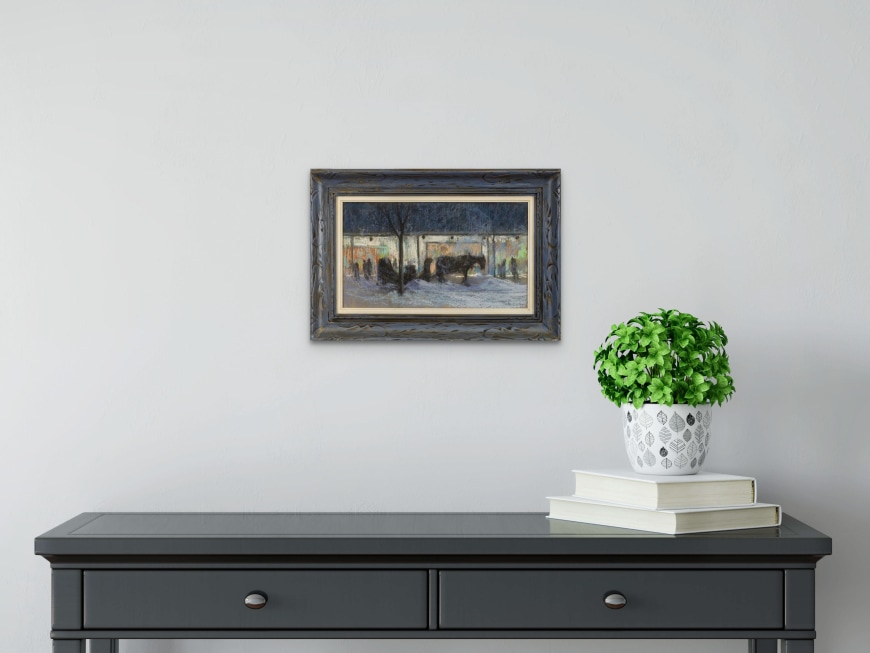25.4 x 45.7 cm
Alan Klinkhoff Gallery Cullen Inventory No. AK1381.
Walter Klinkhoff Gallery Cullen Inventory No. 1381.
Inscriptions
signed, ‘M CULLEN' (lower right)Provenance
Estate of Mrs. Maurice Cullen
Watson Art Galleries, Montreal, Inventory No. 13589
Private collection, Montreal
By descent, private collection, Ontario
Heffel Fine Art Auction House, Fine Canadian Art, 24 November 2006, lot 14
Galerie Walter Klinkhoff Inc., Montreal
Property of a Distinguished Montreal Collector
Literature
Sylvia Antoniou, Maurice Cullen (Kingston: Agnes Etherington Art Centre, Queen's University 1982), 72.
Maurice Cullen, Cab Stand at Night, Montréal, by Jocelyn Anderson
With Cab Stand at Night, Montréal, Maurice Cullen represents a wintery street, an ordinary evening that is made extraordinary through his treatment of the atmosphere. Behind a stark tree, a horse-drawn sleigh waits for a passenger amidst drifts of snow along the edge of the road. On the opposite sidewalk, pedestrians walk past brightly-lit shop windows that glimmer with colourful displays. The entire scene is enveloped in swirls of snow, from the street through the air itself—the rough smudges of pale blue pastel suggest a blizzard.
Though Cullen is better known for his snowy views of the countryside, this work is part of a series he did depicting streets in Montreal in winter between approximately 1908 and 1914 that includes major paintings such as Old Houses, Montreal, c.1908 (Montreal Museum of Fine Arts), St. James Cathedral, Dominion Square, Montreal, c. 1909–12 (Beaverbook Art Gallery), Dominion Square in Snow, 1912, and The Blizzard, Craig Street, 1912 (both Musée national des beaux-arts du Québec), all of which include horse-drawn sleighs. He made cab stands his subjects both in oil (as in Cab Stand, Dominion Square, Montreal, QC, 1911, McCord Stewart Museum) and in pastel.
When Cullen exhibited these works, critics were quick to praise him for his ability to create striking images of the city. In 1909 (the year he submitted Old Houses, Montreal to the exhibition at the Art Association of Montreal), the Gazette declared “we are made to see familiar sights at our very doors, see them without reminisce of other ways of seeing them, so that an ordinary street scene in Montreal is made to reveal its intimate poetry and sentiment though the medium of color [sic] and form” and the critic for the Montreal Daily Star claimed “he has caught the very essence of a storm […] the cold gray bleakness and riving snow without, and the warmth and glow within.”[1] With its contrasts of storm, sleigh, and shops, Cab Stand at Night, Montréal echoes these earlier achievements.
The streets of Montreal were a convenient subject for Cullen (his main studio was in the city), but they also presented a unique artistic challenge because the atmosphere had distinctive tones of light, shadow, and colour at twilight. As Laurier Lacroix has noted, “The industrialization that had been gaining ground for half a century [in Canada] added smoke to cities that were often already enveloped in a morning haze caused by changes in temperature or proximity to a river […] It was apparently in an effort to capture such complex atmospheres that some Canadian artists began portraying the city […] Cullen painted a number of urban views where weather conditions completely alter the scene.” [2] In this respect, Cab Stand at Night, Montréal is a work grounded in the social environment of the city as well as an extension of the artist’s longstanding fascination with winter.
To capture the distinctive atmosphere and swirling snow, Cullen took advantage of the velvety textures of pastels. They were important for his practice: not only had he studied the medium in his early training in Paris, he knew how to make his own. [3] He exhibited pastels regularly alongside his paintings, and critics admired his efforts; for instance, a review in the Witness in 1906 declared “Mr. Cullen has distinguished himself with his pastels. So far as Montreal is concerned, he is unquestionably without a peer in pastel work. His pastels have a strength, a breadth of treatment, and that true velvet texture to the attainment of which all pastel-workers should aspire, but to which very few indeed attain.” [4] Cab Stand at Night, Montréal embodies this talent, and in that it is indicative of the diversity of Cullen’s practice in the 1910s.
Jocelyn Anderson
Jocelyn Anderson is the Deputy Director of the Art Canada Institute. Her research focuses on Canadian art in the late nineteenth and early twentieth centuries, and more broadly on landscape imagery in the British Empire. She is the author of William Brymner: Life & Work, as well as essays for a number of periodicals including British Art Studies and the Oxford Art Journal. She holds a PhD from the University of London (Courtauld Institute of Art).
______________________
Footnotes:
[1]“Exhibition of Art,” Gazette, Montreal, April 3, 1909, 9. “Twenty-Fifth Spring Art Exhibition at Art Gallery,” Montreal Daily Star, April 9, 1909, 6.
[2] Laurier Lacroix, “A Journey Home: Canadian Impressionists Return,” in Canada and Impressionism: New Horizons, 1880–1930 (Ottawa: National Gallery of Canada, 2019), 109.
[3] Sylvia Antoniou, Maurice Cullen, 1866–1934 (Kingston: Agnes Etherington Art Centre, 1982), 18.
[4]Spring Art Exhibition,” Daily Witness, March 24, 1906, clipping in Montreal Museum of Fine Arts Archives Press Clippings, 34 vols., 5:47.














